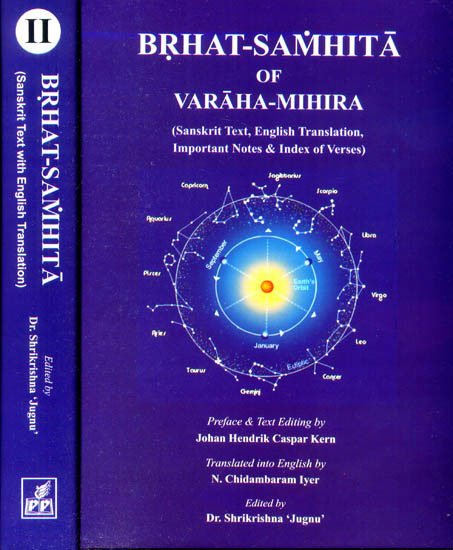Brihat Samhita
by N. Chidambaram Iyer | 1884 | 135,584 words | ISBN-13: 9788171104215
This page describes the features of cows (go) and oxen (vrishabha) which is the sixty-first Chapter of the English translation of the Brihat-samhita. This work, written by Varahamihira in the 6th century, is classified as jyotisha literature, also known as Indian astronomy. It contains however, also content regarding astrology, palmistry, agriculture, gardening, perfumes, medicines and various other encyclopedic topics.
Chapter 61 - On the features of Cows (go) and Oxen (vṛṣabha)
[Sanskrit text for this chapter is available]
1. All that Parāśara told Bṛhadratha about cows (go) and oxen (vṛṣabha), I shall here briefly state. I shall, however, treat scientifically of the animals possessing good features.
2. Cows (go) whose eyes are dim and with tears and disagreeable to look at and whose eyes resemble those of the mouse, will bring on misery. Cows whose horns are moving and flat, whose bodies are rough and whose colour resembles that of the ass, will also bring on evil.
3. Cows having ten, seven or four teeth and those whose heads are hanging and hairless, whose backs are bent or depressed, necks short and thick, hip resembling a grain of barley in shape, whose hoofs are broken, as well as those with long, red, black tongues with small ankles, with a large hump on the back, with thin slender bodies and with either defective or excessive organs, will bring on evil.
4. The ox (vṛṣabha) whose testicle is large and hangs down, whose breast is covered with muscles, whose cheek is large and marked with sinews, and whose penis is thick in three places, will bring on evil.
6. The ox, whose eyes resemble those of the cat, whose colour is brown, whose body is rough, whose lips, jaws and tongue are black, whose breathing is like snoring, and which causes annoyance to the herd of cows, is not fit for the Brāhmaṇas,
7. The ox that passes excrement in large lumps, whose horns do not grow, whose belly is white, whose body is of the colour of the deer and which causes annoyance to the herd of cows (go), is to be rejected though it may be a home-breed one.
8. The ox which is black, of ashy colour, or of the colour of the Sun, and whose eyes resemble those of the cat, is not fit for Brāhmaṇas.
9. The ox, which, while at work lifts up its leg as if from a mire, whose neck is thin and eyes fearful, is an animal of inferior kind. Such animals cannot carry heavy burdens.
10-12. The ox whose lips are soft, close and red, whose ears are small, short and raised up, whose belly is fine, whose ankles are prominent: whose hoofs are red and close, whose breast is strong, the hump on whose back is large, whose skin and hair are fine, soft and thin, whose horns are red and small; whose tail is thin and long, whose eyes are red at the ends, whose breathing is loud, whose shoulders are like those of the lion, whose dewlap is soft and small and whose gait is beautiful, is of an excellent kind.
13. The ox (vṛṣabha), the curl of hair or ringlet on whose left side is from right to left and the one on the right side is from left to right, and whose ankles resemble those of the deer, is an excellent one.
14. The ox whose eyes are like Vaidūrya or the jasmine or the water bubble, whose eye-lids are thick and whose hoofs are close, is also excellent and will carry heavy burdens.
15-16. The ox with a wrinkle at the end of its nose, whose face is like that of the cat, whose right side is white, whose colour is that of the white or blue lotus or red cotton, whose tail is fine and whose speed is like that of the horse; whose testicle is hanging, whose belly is like that of the goat and whose buttocks and breast are contacted, will bring on prosperity, carry heavy burdens and go great distances.
17. The ox which is white, whose eyes are of brown colour, whose horns are red and whose face is large, is known as Haṃsa. It brings on prosperity and an increase of the herd.
18. The ox whose tail hangs to the ground, whose buttocks and eyes are red. and the hump on whose back is fine, and whose body is variously coloured, will make his master the lord of wealth at once.
19. The ox, one of whose legs is white, is also a good one whatever may be his colour. If oxen (vṛṣabha) of excellent sort cannot be had, those of middle importance may be procured and used.
